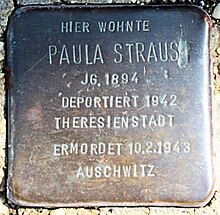
Paula Straus (born January 31, 1894 in Stuttgart; died February 10, 1943 in Auschwitz concentration camp) was a German goldsmith and silversmith.
Life edit
Paula Straus was born as the second daughter of the merchant Leon Straus (d. 1925) and his wife Clara, née Levi (1870-1943). She attended the Staatliche Höhere Mädchenschule in Stuttgart and joined the Wandervogel movement at an early age. From 1911 to 1916, Straus learned goldsmithing at the Staatliche Höhere Kunstgewerbe- und Fachschule für Edelmetallindustrie in Schwäbisch Gmünd. From 1916 to 1919, she worked as an assistant at the gold and silversmithy I. Köhler in Frankfurt am Main and then returned to Stuttgart to the Württemberg School of Applied Arts at the Weißenhof, where she became a master student of Professor Paul Haustein. In 1921 Paula Straus passed her master's examination as a goldsmith here. Initially, she continued to work as a master craftswoman at the Kunstgewerbeschule and quickly gained popularity for her work.
In 1924 Straus showed some of her works at the large Stuttgart Werkbund exhibition Die Form. In 1925, her first solo exhibition followed at the Kunsthalle Mannheim, probably also through the mediation of her cousin Herbert Tannenbaum, an art dealer in Mannheim. In the same year Straus went to Heilbronn and worked for the silverware factory Peter Bruckmann & Söhne. As early as 1926, her designs for Bruckmann were singled out for special praise at the "Württemberg Arts and Crafts" exhibition at the Landesgewerbemuseum in Stuttgart: "The design principle of 'form'," wrote the Stuttgarter Neue Tagblatt, "is probably most clearly expressed in the metalwork created by P a u l a S t r a u ß [sic] in the workshops of Bruckmann, Heilbronn. This is almost the most 'modern' thing to be seen at the exhibition. The line of the devices is wonderfully plausible in its bare clarity.“Other exhibitions where Paula Straus' work was shown were the Mostra Internazionale delle Arti Decorative in 1925, the exhibition Form ohne Ornament in Zurich in 1927, the World's Fair in Barcelona in 1929, and the Exposition de la société des artistes décorateurs in Paris in 1930. In 1929 Paula Straus received a teaching position at the Staatliche Hochschule für Handwerk und Baukunst in Weimar.
In addition to her company studio in Heilbronn, Straus set up a private workshop in Gundelfingen[1] The Stuttgart painter Reinhold Nägele, who was a friend of Paula Straus, painted two views of the village and castle of Niedergundelfingen as seen from Paula Straus' house. In 2005, an exhibition in Gundelfingen commemorated the artist.
On January 31, 1933, Paula Straus left the Bruckmann & Söhne company for economic reasons. Straus had set up her own workshop in Stuttgart's Azenbergstrasse, and from February 1, 1933, she also took up a new position at Württembergische Metallwarenfabrik in Geislingen an der Steige. However, under the pressure of anti-Jewish decrees, she had to give up this position again before the end of 1933.
Paula Straus now worked as a freelance artist, although her radius of action became increasingly restricted. In the summer of 1935, for example, she exhibited at the Jewish Art Exhibition, which was organized by the Jewish Art Community in Stuttgart. As the pressure on Jewish Germans increased, Paula Straus also considered emigration. A house in Gablenbergstraße in Stuttgart, which she had purchased shortly before, had to be sold under pressure at a ridiculous price. After the attempt to emigrate to the Netherlands failed, Paula Straus was banned from working on January 1, 1939. Together with her mother, she was placed in a so-called Judenhaus in the Werfmershalde in Stuttgart. Straus had to go to the Jewish old people's home in Herrlingen near Ulm for "work deployment", and from May 1941 she was employed as a teacher in a home in Haigerloch.
On August 22, 1942, Paula Straus was deported to Theresienstadt from Stuttgart's Killesberg, not far from her former place of work, the Kunstgewerbeschule. On January 29, 1943, she was deported from Theresienstadt to Auschwitz on the "death transport" Ct and murdered there in the gas chamber on February 10, 1943.
Stumbling blocks were laid for Paula Straus and her mother Klara in front of the house at Gablenberger Hauptstraße 173.
Her long-forgotten work was brought to light through exhibitions at the Badisches Landesmuseum Karlsruhe and in theBröhan-Museum in Berlin rediscovered. She is "one of the first industrial designers in Germany". Her estate - 500 letters, photographs and working drawings for silverware, jewelry and Judaica - was donated to the Jewish Museum Berlin in 2015.
Literature edit
- Oskar Wolfer: Die Organisation der Württembergischen Kunstgewerbeschule. In: Fritz Schneider, Julius Frank (Hrsg.): Kunst und Kultur in Schwaben: (Stuttgarter Kunstsommer 1924). Stuttgart: Sentus-Verlag, 1924, Abb. S. 132 („Siegelring, Paula Strauß“), S. 135 („Halsschmuck, Entwurf: Prof. Haustein, Granulationsarbeit: Paula Strauß, Glasschneiderei: Prof. von Eiff“)
- Eduard Reinacher: Goldschmiedearbeiten von Paula Straus. In: Dekorative Kunst, illustrierte Zeitschrift für angewandte Kunst, Bd.: 37 = Jg. 32. 1928/29, S. 240–243 (Digitalisat)
- Silver of a new era: international highlights of precious metalware from 1880 to 1940. Museum Boymans van-Beuningen, Rotterdam, 23.2.92 – 28.4.92; Museum for Sierkunst, Ghent, 26.5.92 – 27.7.92 / [exhibtion organized and catalogus ed. by: A. Krekel-Aalberse, J. R. ter Molen, R .J. Willink] Rotterdam 1992, ISBN 978-90-6918-089-2, S. 138, 142
- Silber aus Heilbronn für die Welt: P. Bruckmann & Söhne (1805 – 1973). Städtische Museen Heilbronn, 11.5. bis 9.9.2002; Bröhan-Museum Landesmuseum für Jugendstil, Art Deco und Funktionalismus, Berlin, Februar bis Mai 2002; Deutsches Klingenmuseum Solingen, Februar bis April 2003 / [Hrsg.: Städtische Museen Heilbronn. Red.: Karlheinz Fuchs] Heilbronn: Städtische Museen, 2001, ISBN 3-930811-90-1, S. 228–229 (biographische Daten), Kat.-Nrn. 47, 48, 50, 99, 171.
- FrauenSilber. Paula Straus, Emmy Roth & Co. Silberschmiedinnen der Bauhauszeit. Badisches Landesmuseum, Karlsruhe 2011, ISBN 978-3-937345-47-5.
References edit
- ^ „…meine verflossene Wahlheimat Gundelfingen…“. Wie die Stuttgarter Goldschmiedin Paula Straus ihre Zuflucht fand und verlor. 2005.
[[Category:1943 deaths]] [[Category:1894 births]] [[Category:People who died in the Holocaust]] [[Category:People who died in Auschwitz concentration camp]] [[Category:Theresienstadt Ghetto prisoners]] [[Category:Silversmiths]] [[Category:Goldsmiths]]